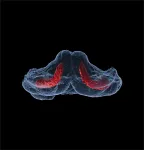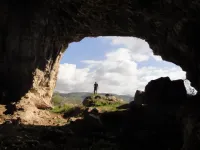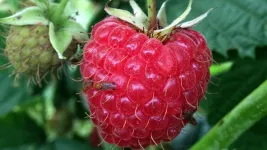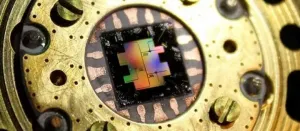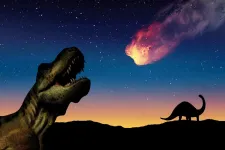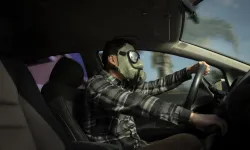INFORMATION:
Avian insights into human ciliopathies
Ciliopathic micrognathia in a chick model results from abnormal skeletal differentiation and remodelling
2021-02-15
(Press-News.org) Ciliopathies are genetic disorders caused by defects in the structure and function of cilia, microtubule-based organelles present on the surface of almost every cell in the human body which play crucial roles in cell signalling. Ciliopathies present a wide range of often severe clinical symptoms, frequently affecting the head and face and leading to conditions such as cleft palate and micrognathia (an underdeveloped lower jaw that can impair feeding and breathing). While we understand many of the genetic causes of human ciliopathies, they are only half the story: the question remains as to why, at a cellular level, defective cilia cause developmental craniofacial abnormalities. Researchers have now discovered that ciliopathic micrognathia in an animal model results from abnormal skeletal differentiation and remodelling. The work from Christian Bonatto Paese, Evan Brooks and others from Samantha Brugmann's lab at the Cincinnati Children's Hospital Medical Center in the USA is published in the journal Development.
The researchers used the avian ta2 mutant as a model for Oral-Facial-Digital syndrome subtype 14 (OFD14), a rare human ciliopathy characterised by micrognathia. They observed defective formation of the jaw bone (mandible) at early stages of development in ta2 mutants. These defects correlated with unchecked progression through the cell cycle and over-proliferation in skeletal progenitor cells. Importantly, these progenitor cells failed to differentiate into mature osteoblasts (the cells that secrete bone), and this failure of differentiation subsequently led to a reduction in bone deposition and hence micrognathia. The researchers also identified excessive bone resorption, a process which normally contributes to final size and shape of the mandible, as an additional causative factor in the ta2 micrognathia. This work informs our understanding of the etiology of human ciliopathic micrognathia.
"We have identified distinct cellular processes that are impaired during the onset of ciliopathic micrognathia," says Samantha Brugmann. "We know from previous work that these processes are responsive to treatment with pharmacological agents, and we are currently testing a number of these agents to determine if 'rescuing' ciliopathic micrognathia is possible. The therapeutic implications are exceptionally real."
"We are also currently trying to uncover how various organ systems respond to loss of cilia and which molecular and signalling pathways are affected, to continue to advance our understanding of how to tackle treatment for patients," says Christian Bonatto Paese.
The paper exemplifies how developmental biology can shine a light on devastating genetic disorders. Brugmann concludes: "The most important impact of this study, to me, is how useful basic science and the avian embryo can be towards uncovering mechanisms for human disease."
ELSE PRESS RELEASES FROM THIS DATE:
Improved use of databases could save billions of euro in health care costs
2021-02-15
Years of suffering and billions of euro in global health care costs, arising from osteoporosis-related bone fractures, could be eliminated using big data to target vulnerable patients, according to researchers at Lero, the Science Foundation Ireland Research Centre for Software.
A study of 36,590 patients who underwent bone mineral density scans in the West of Ireland between January 2000 and November 2018, found that many fractures are potentially preventable by identifying those at greatest risk before they fracture, and initiating proven, safe, low-cost effective interventions.
The multi-disciplinary study, ...
Neanderthals and Homo sapiens used identical Nubian technology
2021-02-15
Long held in a private collection, the newly analysed tooth of an approximately 9-year-old Neanderthal child marks the hominin's southernmost known range. Analysis of the associated archaeological assemblage suggests Neanderthals used Nubian Levallois technology, previously thought to be restricted to Homo sapiens.
With a high concentration of cave sites harbouring evidence of past populations and their behaviour, the Levant is a major centre for human origins research. For over a century, archaeological excavations in the Levant have produced human ...
Invasive flies prefer untouched territory when laying eggs
2021-02-15
A recent study finds that the invasive spotted wing drosophila (Drosophila suzukii) prefers to lay its eggs in places that no other spotted wing flies have visited. The finding raises questions about how the flies can tell whether a piece of fruit is virgin territory - and what that might mean for pest control.
D. suzukii is a fruit fly that is native to east Asia, but has spread rapidly across North America, South America, Africa and Europe over the past 10-15 years. The pest species prefers to lay its eggs in ripe fruit, which poses problems for fruit growers, since consumers don't want to buy infested fruit.
To avoid consumer rejection, there are extensive measures in place to avoid infestation, and to prevent infested ...
New physics rules tested on quantum computer
2021-02-15
Aalto researchers have used an IBM quantum computer to explore an overlooked area of physics, and have challenged 100 year old cherished notions about information at the quantum level.
The rules of quantum physics - which govern how very small things behave - use mathematical operators called Hermitian Hamiltonians. Hermitian operators have underpinned quantum physics for nearly 100 years but recently, theorists have realized that it is possible to extend its fundamental equations to making use of Hermitian operators that are not Hermitian. The new equations describe a universe with its own peculiar set of rules: for example, by looking in the ...
The comet that killed the dinosaurs
2021-02-15
It was tens of miles wide and forever changed history when it crashed into Earth about 66 million years ago.
The Chicxulub impactor, as it's known, left behind a crater off the coast of Mexico that spans 93 miles and goes 12 miles deep. Its devastating impact brought the reign of the dinosaurs to an abrupt and calamitous end by triggering their sudden mass extinction, along with the end of almost three-quarters of the plant and animal species then living on Earth.
The enduring puzzle has always been where the asteroid or comet that set off the destruction originated, and how it came to strike the Earth. And ...
Managing crab and lobster catches could offer long-term benefits
2021-02-15
The UK's commercial fishing industry is currently experiencing a number of serious challenges.
However, a study by the University of Plymouth has found that managing the density of crab and lobster pots at an optimum level increases the quality of catch, benefits the marine environment and makes the industry more sustainable in the long term.
Published today in Scientific Reports, a journal published by the Nature group, the findings are the result of an extensive and unprecedented four-year field study conducted in partnership with local fishermen off the coast of southern England.
Over a sustained period, researchers exposed sections of the seabed to differing densities of pot fishing and monitored any impacts using a combination of underwater videos and catch ...
Comet or asteroid: What killed the dinosaurs and where did it come from?
2021-02-15
It forever changed history when it crashed into Earth about 66 million years ago.
The Chicxulub impactor, as it's known, left behind a crater off the coast of Mexico that spans 93 miles and runs 12 miles deep. Its devastating impact brought the reign of the dinosaurs to an abrupt and calamitous end by triggering their sudden mass extinction, along with the end of almost three-quarters of the plant and animal species living on Earth.
The enduring puzzle: Where did the asteroid or comet originate, and how did it come to strike Earth? Now, a pair of researchers at the Center for Astrophysics | Harvard & Smithsonian believe they have the answer.
In a study published today in Nature's Scientific Reports, Harvard University ...
A machine-learning approach to finding treatment options for Covid-19
2021-02-15
When the Covid-19 pandemic struck in early 2020, doctors and researchers rushed to find effective treatments. There was little time to spare. "Making new drugs takes forever," says Caroline Uhler, a computational biologist in MIT's Department of Electrical Engineering and Computer Science and the Institute for Data, Systems and Society, and an associate member of the Broad Institute of MIT and Harvard. "Really, the only expedient option is to repurpose existing drugs."
Uhler's team has now developed a machine learning-based approach to identify drugs already on the market that could ...
Commuters are inhaling unacceptably high levels of carcinogens
2021-02-15
A new study finds that California's commuters are likely inhaling chemicals at levels that increase the risk for cancer and birth defects.
As with most chemicals, the poison is in the amount. Under a certain threshold of exposure, even known carcinogens are not likely to cause cancer. Once you cross that threshold, the risk for disease increases.
Governmental agencies tend to regulate that threshold in workplaces. However, private spaces such as the interior of our cars and living rooms are less studied and less regulated.
Benzene and formaldehyde -- both used in automobile manufacturing -- are known to cause cancer at or above certain levels of ...
Strange creatures accidentally discovered beneath Antarctica's ice shelves
2021-02-15
Far underneath the ice shelves of the Antarctic, there's more life than expected, finds a recent study in the journal Frontiers in Marine Science.
During an exploratory survey, researchers drilled through 900 meters of ice in the Filchner-Ronne Ice Shelf, situated on the south eastern Weddell Sea. At a distance of 260km away from the open ocean, under complete darkness and with temperatures of -2.2°C, very few animals have ever been observed in these conditions.
But this study is the first to discover the existence of stationary animals - similar to sponges and potentially several previously unknown species - attached to a boulder on the sea floor.
"This discovery is one of those ...
LAST 30 PRESS RELEASES:
Signature patterns of brain activity may help predict recovery from traumatic brain injury
Dresden study uncovers new key mechanism in cancer cells
New species are now being discovered faster than ever before, study suggests
Cannabis-based products show limited short-term benefit for chronic pain, with increased risk of adverse effects
Cannabis products with more THC slightly reduce pain but cause more side effects
Clearing the brain of aging cells could aid epilepsy and reduce seizures
Brain injuries linked with potential risk of suicide, new study finds
New technique lights up where drugs go in the body, cell by cell
New study finds movement of fishing fleets can reveal shifts in marine ecosystems
Embargoed: New evidence points to potential treatment for vascular dementia
Study uncovers disrupted brain balance in alcohol dependence
Working in groups can help Republicans and Democrats agree on controversial content moderation online
Structural findings reveal how distinct GPCR ligands create different levels of activation
Anything-goes “anyons” may be at the root of surprising quantum experiments
UC review: Maximizing workplace opportunity for veterans
From generation to complex control: Metasurfaces make perfect vortex beams "within reach"
Thin-film lithium niobate-based detector: recent advances and perspectives
Exploring why some people may tend to persistently make bad choices
How cells balance their protein levels
Nirsevimab vs RSVpreF vaccine for RSV–related hospitalization in newborns
Effectiveness and impact of maternal RSV immunization and nirsevimab on medically attended RSV in US children
AI gives scientists a boost, but at the cost of too many mediocre papers
Next-generation vision model maps tree growth at sub-meter precision
Genes aren’t destiny for inherited blindness, study shows
MIT study: High-fat diets make liver cells more likely to become cancerous
Exposure to multiple fine particulate matter components and incident depression in the US Medicare population
Risk of burdensome health care spending over time in the US
Nirsevimab against hospitalizations and emergency department visits for lower respiratory tract infection in infants
New microfluidics technology enables highly uniform DNA condensate formation
A new strategy for immune tolerance
[Press-News.org] Avian insights into human ciliopathiesCiliopathic micrognathia in a chick model results from abnormal skeletal differentiation and remodelling
